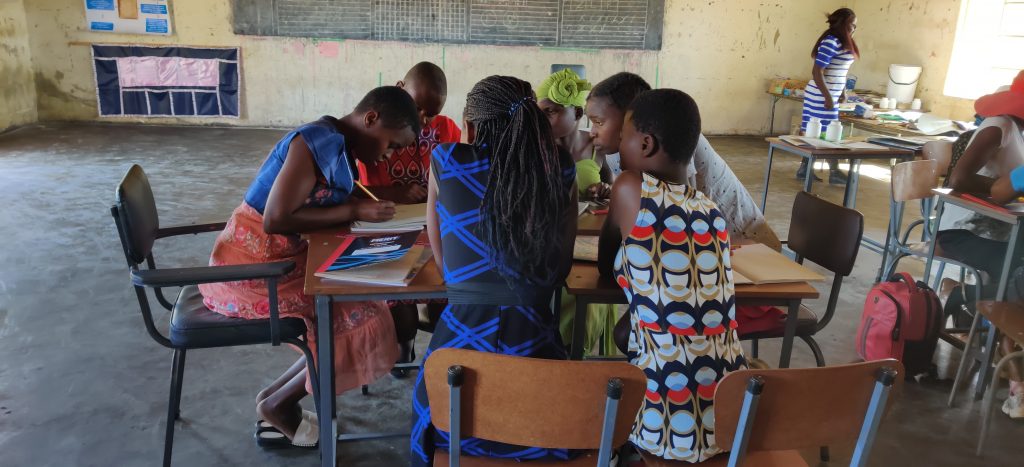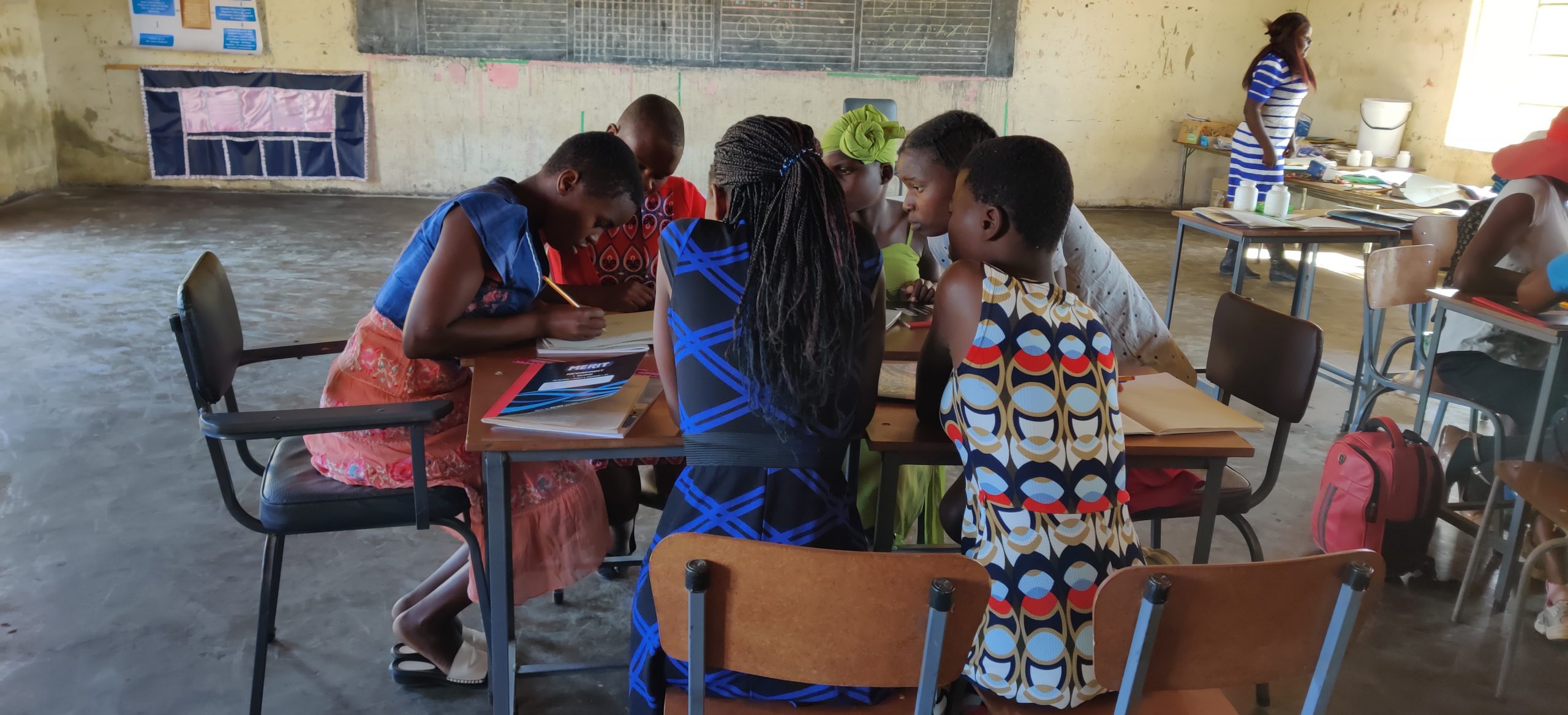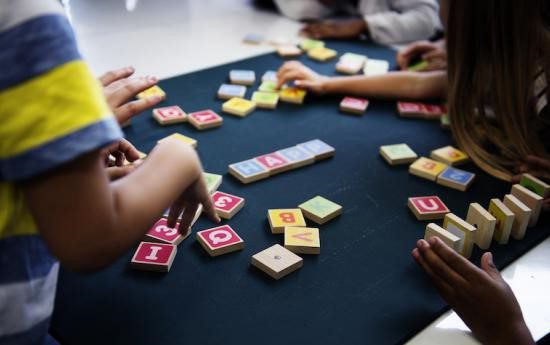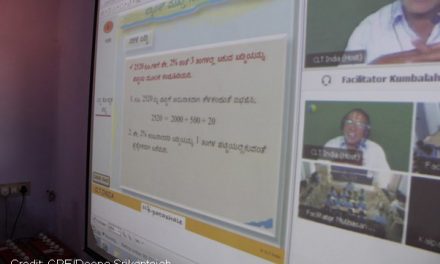This blog post was written by Clare Woodward (Lecturer in International Education at The Open University) with contributions from Stephen Harrison and Clare Tope (academics in Education and Youth Studies), as well as other colleagues at the Open University and partner organisations.
It’s a sunny morning and I’m just getting ready to co-facilitate a 2-hour workshop; participants are coming in slowly, waving and greeting each other. But this is no ordinary workshop. While I’m at my laptop in Wales, my co-facilitator is in Harare, the participants are from all over Matabeleland, Zimbabwe, the waves and greetings are emojis and the workshop location is a WhatsApp group.
 Many girls across Zimbabwe face a number of complex and inter-dependent barriers to accessing education, including gender, age, religion, economic status, ethnicity and disability. Girls’ limited access to education is underpinned by pervasive gender inequality. The Supporting Adolescent Girls’ Education (SAGE) project in Zimbabwe, is funded by UK Aid through the Girls’ Education Challenge and led by Plan International UK. Working in Zimbabwe with the Ministry of Primary and Secondary Education, the SAGE project works with highly marginalised and out-of-school adolescent girls to improve their learning outcomes in literacy and numeracy and support them as they transition to education, training or employment. The consortium, which includes The Open University (OU), focuses on providing high-quality, accelerated, non-formal education in accessible, girl-friendly community-based Learning Hubs located across the country. Each Learning Hub Volunteer team (HV) includes Community Educators, Learning Assistants, In-school Buddies and Champions of Girls’ Education facilitators, all working together to support the girls.
Many girls across Zimbabwe face a number of complex and inter-dependent barriers to accessing education, including gender, age, religion, economic status, ethnicity and disability. Girls’ limited access to education is underpinned by pervasive gender inequality. The Supporting Adolescent Girls’ Education (SAGE) project in Zimbabwe, is funded by UK Aid through the Girls’ Education Challenge and led by Plan International UK. Working in Zimbabwe with the Ministry of Primary and Secondary Education, the SAGE project works with highly marginalised and out-of-school adolescent girls to improve their learning outcomes in literacy and numeracy and support them as they transition to education, training or employment. The consortium, which includes The Open University (OU), focuses on providing high-quality, accelerated, non-formal education in accessible, girl-friendly community-based Learning Hubs located across the country. Each Learning Hub Volunteer team (HV) includes Community Educators, Learning Assistants, In-school Buddies and Champions of Girls’ Education facilitators, all working together to support the girls.
COVID-19 current restrictions in Zimbabwe, including the closure of the community Learning Hubs, means a return to the isolation and barriers that have prevented these young girls from accessing learning all their lives. To counteract that, a series of live workshops is taking place, using the text facility of WhatsApp to enable the HVs to continue to engage in meaningful learning conversations with their learners at a distance, operating within the current restrictions. These workshops aim to build confidence and capacity amongst the HVs to enable them to continue supporting their learners at a distance, through mobile phones.
Africa in general has been an early adopter of WhatsApp and the HVs in the SAGE project are very comfortable in using it to communicate with their friends and family. The OU has traditionally supported the use of technology for learning that its audience and learners are familiar with – TV in the early days of distance courses, moving to PCs and on to mobile phones, for example in the English in Action (EIA) programme in Bangladesh. It’s therefore a natural position for the OU to embrace users’ familiarity with WhatsApp as an opportunity for innovation in the Coronavirus pandemic. The recent blog posting Minimising ‘distance’ in distance learning programmes during a global health crisis: framing an international education response to COVID-19 by Alison Buckler, Liz Chamberlain, Kris Stutchbury and Claire Hedges frames the OU response to these challenges around five interlinked priorities: Retention, Relationships, Refocussing, Reflection and Resilience. This initiative by SAGE resonates strongly with this approach.
The low-resource context of Zimbabwe makes the multi-participant, text-only synchronicity of WhatsApp a perfect tool for quite large-scale workshops – the largest up to now has had 74 participants. Multi 2-hour workshops have taken place with an average of 45 participants per workshop, each joining in from their own homes. Each workshop is attended by HVs from a single district in Zimbabwe and follow-up workshops take place regularly. The project works across 11 districts. Set up locally by Plan International, a workshop is run by 2 facilitators, one local from Plan and one from the OU. Stimulus materials on a Word document are shared with participants in advance and a set of questions is asked by the local facilitator during the workshop. Should participants in the workshops wish to use their own language, Google translate is a useful tool for the OU facilitator!
The focus of the first set of workshops was on the challenges that HVs may face when trying to support girls at a distance. In my first workshop, HVs discussed extensively problems in dealing at a distance with girls who are disabled and have visual or hearing difficulties; others have found that many girls have limited access to a mobile phone and most of them shoulder a lot of responsibilities at home. How can we help them to retain their new identities as learners? asks one participant. By thinking through these issues together the workshop, helps HVs reach decisions on how best to engage with their learners. Like all workshops, there are differences of opinion where things can get quite lively! And quiet moments where the group seems to flag a little. At these times, energisers are used to great effect by the local Plan facilitator (such as local songs or games) to lighten the mood! It is even possible to inject a bit of humour into the session, for example:
Is there anyone else with a burning🔥question?
Thank goodness for emojis!
The slower speed necessitated by the use of text (due to bandwidth and affordability) allows time for reflection and supports broader participation than in many face-to-face workshops. It has also led to facilitators developing useful techniques to maximise the technology while moving the learning forward. Approaches such as the use of the forward arrow to return to comments and asking responders to explain further or for others to comment; adding ‘please explain’ to an answer that was just ‘yes’ or copying a comment and responding ‘Thank you for raising this – what do others say?’ Frequent short summaries support the clarity of key points and ensure that the same answer is not repeated. This replicates what might traditionally be recorded on a flip chart during a session. The use of two facilitators, with one leading and the other offering encouraging emojis for helpful suggestions and then exchanging roles, offers the potential for the text-based exchanges to become a conversation. The ability to archive the chats also means that advice and suggestions can be referenced in future workshops.
A parallel WhatsApp ‘backroom’ group runs concurrently, where consortium members from Plan and The OU can follow the conversations and offer support when necessary. This parallel ‘backroom’ also allows the co-facilitators a space to have conversations away from the workshop about issues that are arising through the discussion.
These workshops, set up as a ‘just in time’ initiative to counter the issues of COVID-19 restrictions on access to vulnerable girls in Zimbabwe, are offering a wealth of opportunity for both the development of similar approaches in other currently restricted environments and for research into the power of text-based synchronous workshops as a reflective tool.
Today’s workshop comes to an end after a lively two hours and we all leave expressing our pleasure in having got together and helped each other resolve some difficult issues and argue over others. A follow-on workshop is planned for 2 weeks’ time where the same group of HVs can share experiences and shoulder together the difficulties of supporting these vulnerable young learners under the shadow of COVID-19.





